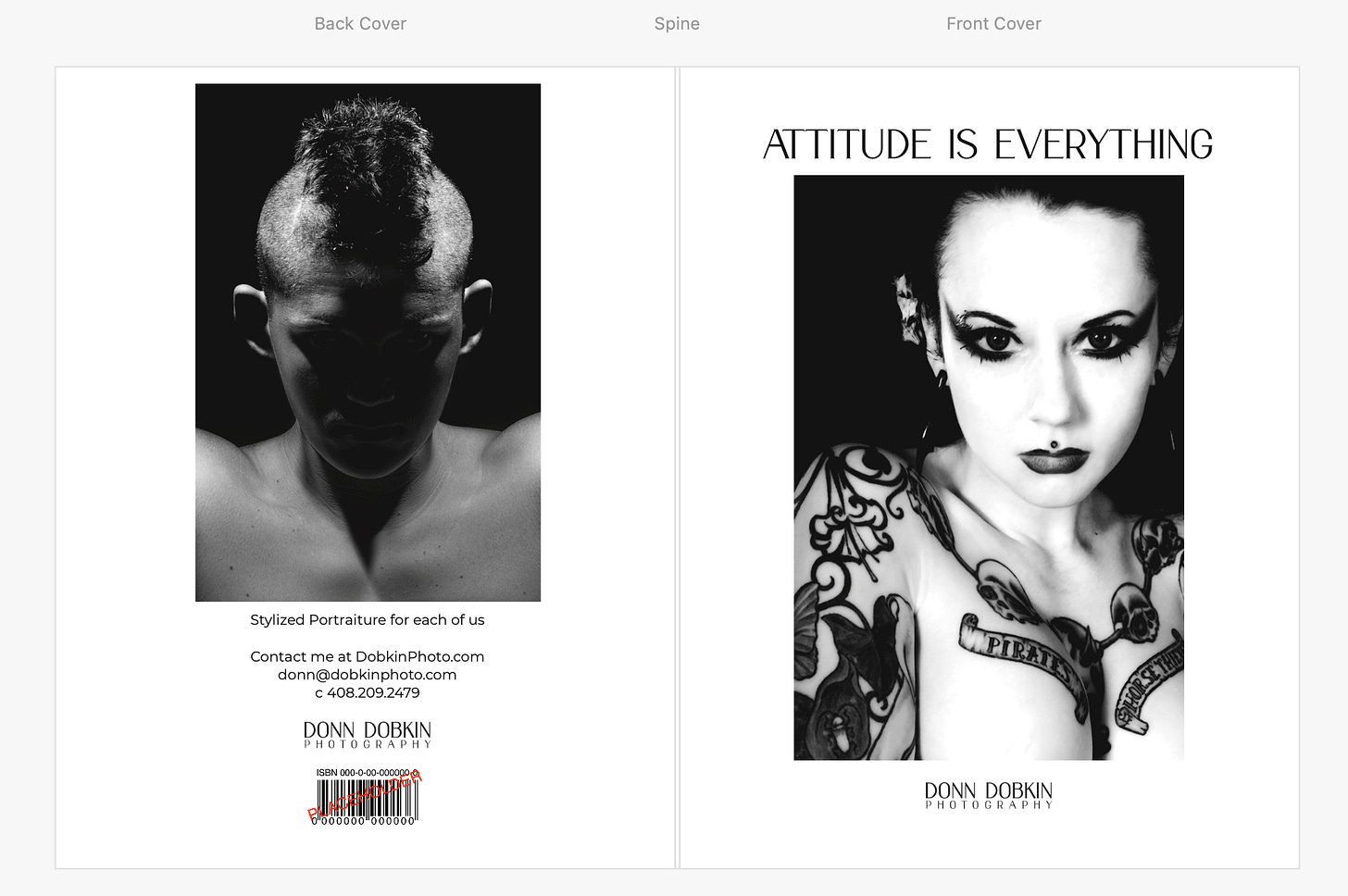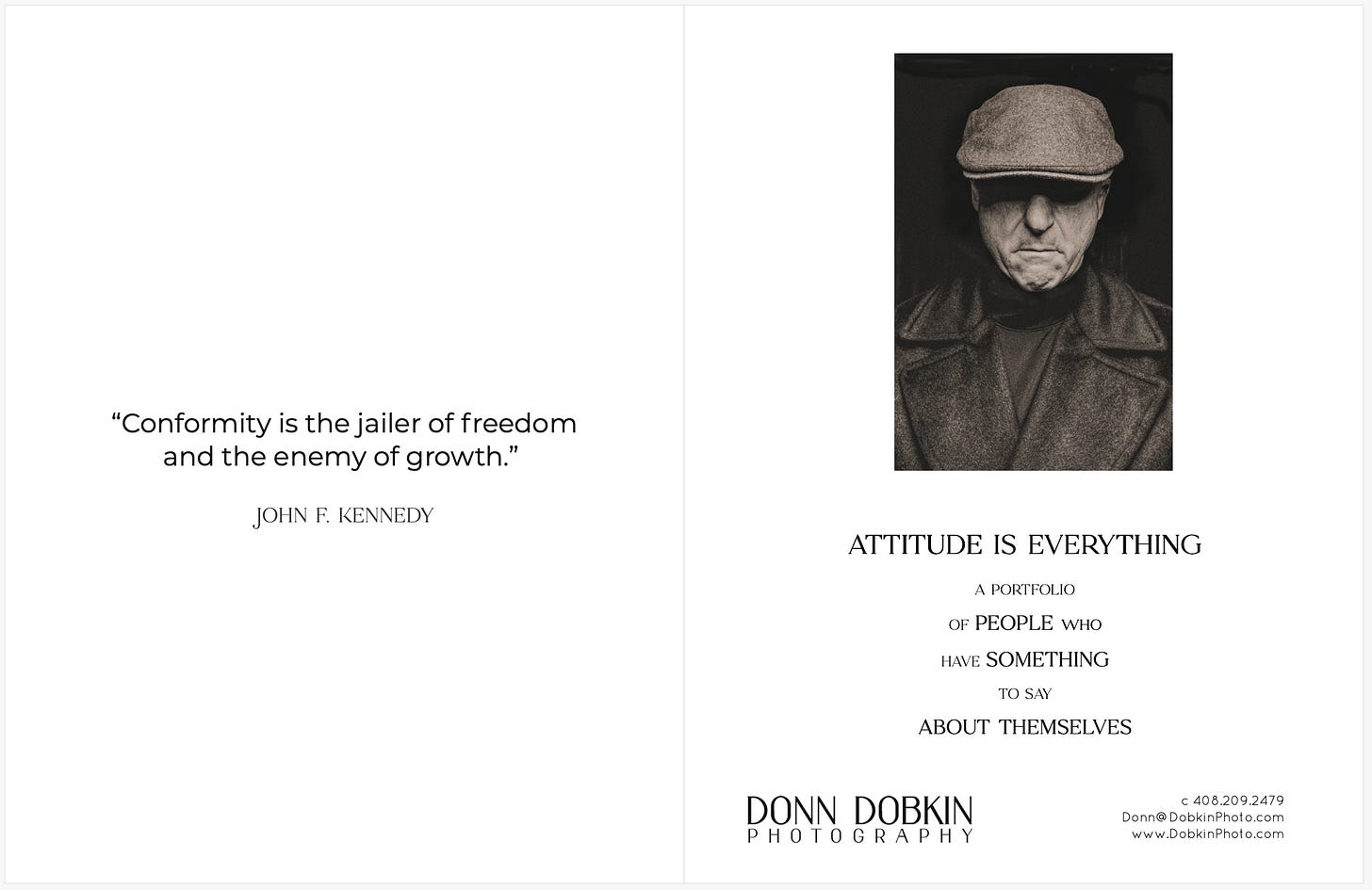This topic comes to mind because I’m actively working on a book that I’ll market and sell later this year. I will, dammit! More about that pretty soon.
I’ll start this letter by saying you don’t need one. A grand purpose, I mean. If you’re a photographer or any other artist of imagery, just make a book, right away if possible. You can make something with a modest number of pages in very little time and for just a few dollars1, whether you call it a ‘zine or a book (For me, they’re all books). Don’t set your initial expectations too high, and I promise you’ll be happy you made one. I promise you. Even if you just throw the thing away, you’ll be glad you did it. If you like your initial idea you can make a revised version later.
The book below will never be used, although I may come back to parts of it down the road. I’ve kept it around to remind myself of the product, which is an impressive one from MagCloud, see the footnote below.2
Why won’t I use it? The concept of combining these topics just doesn’t work (duh in retrospect), and I don’t like some of the image choices I made. But I have zero regrets. I learned things, including different ways to work with fonts and page design.
What if you don’t care about that? Why should you make a book? There can be high-purpose reasons to produce books, no doubt. But if it’s been a while since you made one, or if you never have, consider these:
Making physical collections of work will cause you to think differently, see your work differently, and allow for a different level of reflection. The book can sit in a drawer or on a shelf, allowing you to leaf through it at any time later… and seeing your work that way is just so different than staring into a monitor or a phone. Most of us who make things, from photos to poems to furniture, we go through different phases. Our work may shift in subject matter, artistic style, or some other shift. Making books, now and later, will provide a new perspective on that. And it can actually cause shifts while you are creating any given book.
We all love to show our best individual images. But “best” when it comes to storytelling or exploring a theme is on a different vector. Maybe an individually excellent image just doesn’t fit the story (boy, is that hard to accept!). But stories and themes can reveal new value for images that you had previously set aside, and they can cause you to go out and make new things that you wouldn’t otherwise make, to complete a story or fill out a theme. I’ve been experiencing that big-time the last month or so with my upcoming book. I’ve gone out much more often to fill gaps or improve stories, or to get better images of the same subject. And “better” is not at all a literal term here, not always. The goals include fitting images together on a page or spread. So sometimes a new representation of an existing subject is needed for that reason alone.3
Books provide a different experience when sharing. Just hand the thing to somebody. If you want them to actually look at it, the chances they will examine a physical copy are higher than with images they (don’t really) see while scrolling. And weirdly, you’ll look at your own work more closely in book form, too. You let me know if that’s not the case for you.
It just plain feels good to hold your own book in your hand. You’ll just have to trust me if you’ve never made one before.
I’ve got three books that are available in the public domain4 and several that are just here in my office. There are also some which have not been presented publicly. Among those are portfolio books.
Following are screenshots of some pages from a book I made in 20235. The book was designed to help me establish a portraiture business for a specific target market. I imagine it will help, if I ever get back to pursuing this market and that business. (Dang, I need 48 hours in a day. At least!)



This book wasn’t produced in an hour, because I spent time getting quotes and putting in the text. But if I’d just wanted to put the images together, add simple captions and make the cover and inside covers, it could be done in an hour. Seriously.
So. Do this yourself, and see your own work in a new light. No excuses, just get started and thank me later! You can’t finish until you begin.
This concludes my public service announcement for the month of May.
Until next time,
Is there something here you like or dislike? Questions? Have anything else to say? Let us all know by clicking on the Comments button below, and express yourself. Don’t be shy, now.
If you like this post you’re bound to like the next one as well. I’m sending them weekly. Quit any time, or better yet, stay and read on!
Know anybody who should hear about all this? Be a friend and let them know!
Or, are you interested in seeing more work? My website welcomes you. We may even want to work together. I promise a joyous and productive experience if we do.
Visit: www.dobkinphoto.com
The quality of the Blurb “Premium Magazine” is outstanding, and one 20-page book is only $7.00 before discounts. A 30 page book would be $9.00 before discounts. They have discounts all the time, I see one currently at 40% off. Shipping to Virginia is $3.99 if you can accept the slow boat for transit; if ordered today they would promise delivery in 16 days. They usually beat their promise dates. How about that, a 30-page custom book delivered to your home for less than $10 even though you’re ordering a quantity of one.
This is an amazing product, a spiral-bound 11x17” Tabloid. The scale of it is hard to ignore, and the print quality will shock you for the price. The one I made was 78 pages (90 is max), it weighs 2.4 pounds, and the price without discounts is $30.08. Crazy for something so huge.
However, you need to make your own book with a publishing tool to work with MagCloud. I used Affinity Publisher. I don’t love learning software tools. OK that’s a lie, I pretty much hate it! But thanks to AI, Perplexity.ai in particular, I can quickly ask how to do something in Affinity, or why I can’t do something else, best practices, etc., and suddenly I’m able to make things that I couldn’t make before. It’s a game-changer, life-saver, pick your favorite, loving description.
This is a non-trivial task where wildlife is involved, given that the subjects won’t stand where I’d like, with lighting and backgrounds that suit me! But there are issues that might need to be resolved. Do the background colors of the images work together? Do the scenes, the postures, and the compositions work together? The exposures? Can this be solved by reorganizing, or do we need new material?For a book to work well, that stuff matters. The relative importance of continuity depends on how the book is constructed.
Click here to see them. The first and third titles are hardcover, coffee table books and the middle one is a Blurb Premium Magazine, 24 pages.









